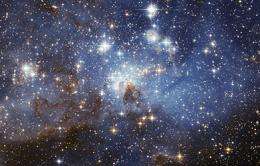Galaxies are running out of gas: study

(PhysOrg.com) -- A new study has shown why the lights are going out in the Universe.
The Universe forms fewer stars than it used to, and a CSIRO study has now shown why - the galaxies are running out of gas.
Dr Robert Braun (CSIRO Astronomy and Space Science) and his colleagues used CSIRO’s Mopra radio telescope near Coonabarabran, NSW, to study far-off galaxies and compare them with nearby ones.
Light (and radio waves) from the distant galaxies has taken time to travel to us, so we see the galaxies as they were between three and five billion years ago.
Galaxies at this stage of the Universe’s life appear to contain considerably more molecular hydrogen gas than comparable galaxies in today’s Universe, the research team found.
Stars form from clouds of molecular hydrogen. The less molecular hydrogen there is, the fewer stars will form.
The research team’s paper is in press in Monthly Notices of the Royal Astronomical Society.
Astronomers have known for at least 15 years that the rate of star formation peaked when the Universe was only a few billion years old and has declined steeply ever since.
"Our result helps us understand why the lights are going out," Dr Braun said.
"Star formation has used up most of the available molecular hydrogen gas."
After stars form, they shed gas during various stages of their lives, or in dramatic events such as explosions (supernovae).
This returns some gas to space to contribute to further star formation.
"But most of the original gas—about 70%—remains locked up, having been turned into things such as white dwarfs, neutron stars and planets," Dr Braun said.
"So the molecular gas is used up over time. We find that the decline in the molecular gas is similar to the pattern of decline in star formation, although during the time interval that we have studied, it is declining even more rapidly."
Ultimately, the real problem is the rate at which galaxies are 'refueled' from outside.
Gas falls into galaxies from the space between galaxies, the intergalactic medium. Two-thirds of the gas in the universe is still found in the intergalactic medium and only one third has already been consumed by previous star formation in galaxies, astronomers think.
"The drop-off in both gas availability and star formation seems to have started around the time that Dark Energy took control of the Universe," Dr Braun said.
Up until that time, gravity dominated the Universe, so the gas was naturally pulled in to galaxies, but then the effect of Dark Energy took over and the Universe started expanding faster and faster.
This accelerating expansion will have made it increasingly difficult for galaxies to capture the additional gas they need to fuel future generations of star formation, Dr Braun speculates.
The galaxies used for the Mopra study were of a kind called ultra-luminous infra-red galaxies or ULIRGs, chosen because they are known to have large reservoirs of gas and because they are so bright that there was a complete census of them within the volume of the Universe that the team studied. They ranged in redshift from 0.2 to 0.5 (that is, they had a look-back time of three to five billion years).
Molecular hydrogen is difficult to detect directly, and this study (like many previous studies) used emission from carbon monoxide (CO) as a proxy for the molecular hydrogen. The astronomers observed the emission arising from the CO(1-0) transition: this study is significant because most other studies have had to rely on observing different transition lines for galaxies at different redshifts. This study, however, compared "apples with apples", using CO(1-0) for both the nearby and distant galaxies under study.
Provided by CSIRO

















